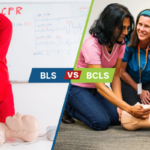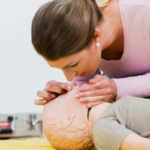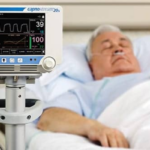- Last Updated On: June 12, 2024
Is There an Age Limit for CPR Certification? Find Out Here
While many of us are familiar with the importance of CPR, there are still quite a few misconceptions about this important medical procedure. Confusion about how long it takes to earn your certification, how old you must be to get CPR-certified, and whether you can perform CPR without a certification are just a few of the common questions people have about CPR.
Some organizations require students to be at least 12 years old to attend a CPR class, others don’t. However, there is no age limit to teaching your children CPR techniques. Because many sudden cardiac arrest cases occur at home, it’s essential to arm family members and household members of all ages with CPR knowledge.
At American CPR Care Association, we give you the tools to feel confident responding to cardiac arrest and other medical emergencies. Our CPR certification online course gives you the tools to control your learning pace while gaining hands-on experience. Continue reading to learn why no one is too young to learn about CPR certification.
Are Children Capable of Learning and Performing CPR?
The American Heart Association suggests that children as young as nine can learn CPR. Numerous studies also support children learning CPR. One study conducted by Dr. Fritz Sterz at the Medical University of Vienna saw nine out of ten children perform CPR correctly. However, only 69% completed the mouth-to-mouth resuscitation portion correctly.
The study’s findings suggest hands-only CPR might be more effective than mouth-to-mouth resuscitation for children performing CPR. The study also revealed that most of the participants retained their skills after the training ended, showing that this information can easily be retained by children.
However, the lack of the children’s physical development hindered some of the participants from performing CPR correctly on adults. The lack of physical strength suggests children might be better suited performing CPR on other children. Despite the strength limitations, there have been many instances where children have saved adults’ lives using CPR, so children should still perform CPR on adults in cardiac arrest.
How to Bring a CPR Training Program into Your Child’s School
You can work with your local community to bring programs to your schools and youth. For example, the Boy and Girl Scouts of America, the American Heart Association, and the Red Cross have training programs specifically designed to teach children how to safely and effectively perform CPR. Local emergency services might also lend some guidance.
Some states already require kids to know CPR. Typically, these requirements only apply to high school students. Because the requirements typically only apply to high school students, making connections with local organizations can be a valuable step in the right direction for streamlining CPR training for kids.
How to Teach CPR to Your Child
You can also take your CPR skills home and impart them to your child. To do this, you must first earn your own CPR certification. The American Heart Association recommends starting your training with hands-only CPR.
There are two steps to performing hands-only CPR. First, you should call 911. If someone else is with you, tell them to call 911 and begin searching for an AED while you begin chest compressions.
To perform chest compressions, you should place your hands in the center of the chest, at the end of the breastbone. You need to make sure the chest compressions are deep enough (2 inches) to produce enough force to circulate the blood throughout the victim’s body.
You should perform chest compressions for 30 compressions at 120 bpm, which roughly equates to the tempo of “Stayin Alive” by the Bee Gees. After 30 compressions, you can perform two rescue breaths. Even if you aren’t comfortable performing rescue breaths, you should still take a break to recover. Chest compressions that aren’t deep enough are ineffective and if you are tired, you might lose the ability to perform chest compressions at the correct depth.
The Value of Learning CPR at Any Age
The difference between having someone around with CPR training and not having someone around with CPR training can mean the difference between life and death during a cardiac arrest emergency. Approximately 350,000 sudden cardiac arrest cases occur every year. Of those cases, 90% don’t survive.
With every second that a victim doesn’t receive CPR, their chances of survival decrease by ten percent. Many cardiac arrests occur at home, as well, meaning the victim’s only chance is that a family member trained in CPR can help. If cardiac arrest victims receive CPR within the first few minutes of cardiac arrest, their survival chances can double or even triple. Because of this, children should know CPR.
Are BLS and CPR the Same Thing?
Is BLS the same as CPR? The answer is no. Basic Life Support is a more in-depth course based on working in teams of two or three professional rescuers. CPR only teaches you the essentials of CPR in times of cardiac arrest and some other unconscious situations.
CPR is also a lifesaving technique, while BLS covers a wider range of medical response protocols. The average person doesn’t have the medical expertise necessary to assess a victim’s condition or perform airway maintenance, key procedures covered in BLS courses.
Is There an Age Limit for BLS Certification?
The minimum age to attend a CPR class varies from organization to organization and there is no formal age limit. However, BLS is a more advanced course, and it is geared mostly toward medical professionals. Bystanders can get their BLS certification to improve their medical emergency response skills, but the course material is more advanced than CPR certification courses.
Can You Perform CPR If You Are Not CPR Certified?
Being CPR-certified does not mean you are licensed to perform CPR. Though many organizations require CPR certification, you do not have to carry proof of certification to perform CPR in an emergency.
Good Samaritan Laws protect anyone who attempts to perform CPR on a victim. The choice is clear: it’s better to perform CPR on a victim than to stand by and do nothing, regardless of whether you have CPR training. However, formal CPR training gives you the courage, information, and confidence to act quickly and decisively in emergencies.
Purposes of Certification
People earn their CPR certification for a multitude of reasons. Some are personal and some are professional. In the case of children learning CPR, the reason is most likely for family health.
Approximately 70 percent of sudden cardiac arrests occur at home. This statistic reveals the importance of children getting at least some formal knowledge of CPR techniques. Some other reasons for CPR certification include:
Employment: Many professions require CPR certification, particularly those requiring interactions with the public or those with a potential for workplace injuries.
Proficiency and Civil Service: emergencies are terrifying, but they’re even more frightening if bystanders don’t know how to react. Many civilians get their CPR certification to respond more confidently. The more CPR knowledge one has at their disposal, the quicker they can respond in an emergency.
Barriers to CPR Training
Most people don’t attend CPR classes because they think it will take too much time. The great news is, with online certification and blended courses, you can earn your CPR certification at your own pace.
You might also think your child is too young to learn CPR. This is not the case. Just because your child might be too young to earn their certification doesn’t mean you can’t teach them yourself once you’re CPR certified. There is no telling where and when emergencies will strike. The more CPR-certified people, and the more people with CPR training, the more likely someone can respond decisively and effectively, increasing the potential to save a life.
Conclusion
Answering whether there is an age limit for CPR certification is a nuanced question. Some organizations require their students to be at least 12 years old. However, what’s most important in this discussion is that you don’t have to be a certain age to learn CPR.
There is a glaring need for more CPR-certified civilians, and CPR-certified individuals can instill the skills and explain the importance of CPR to their children. Doing so increases the likelihood that those children will seek out CPR certification themselves or respond to emergencies.
At American CPR Care Association, we ensure all of our students have the necessary skills to respond to cardiac arrest emergencies quickly and decisively. Our online and blended CPR course gives students the tools they need to save lives.
Register today to earn your CPR certification.






